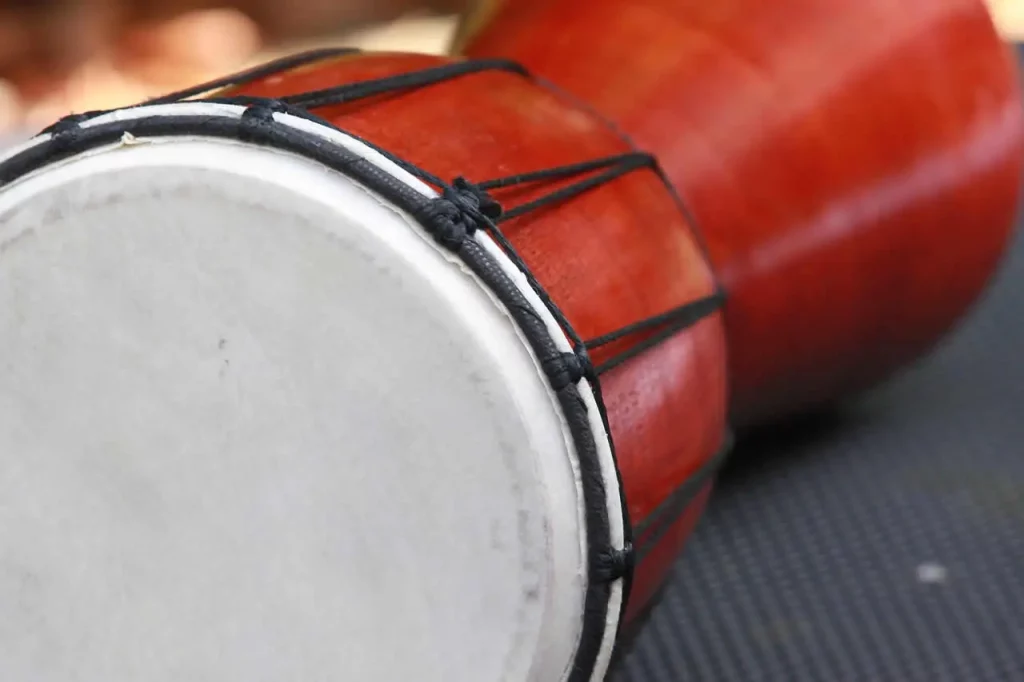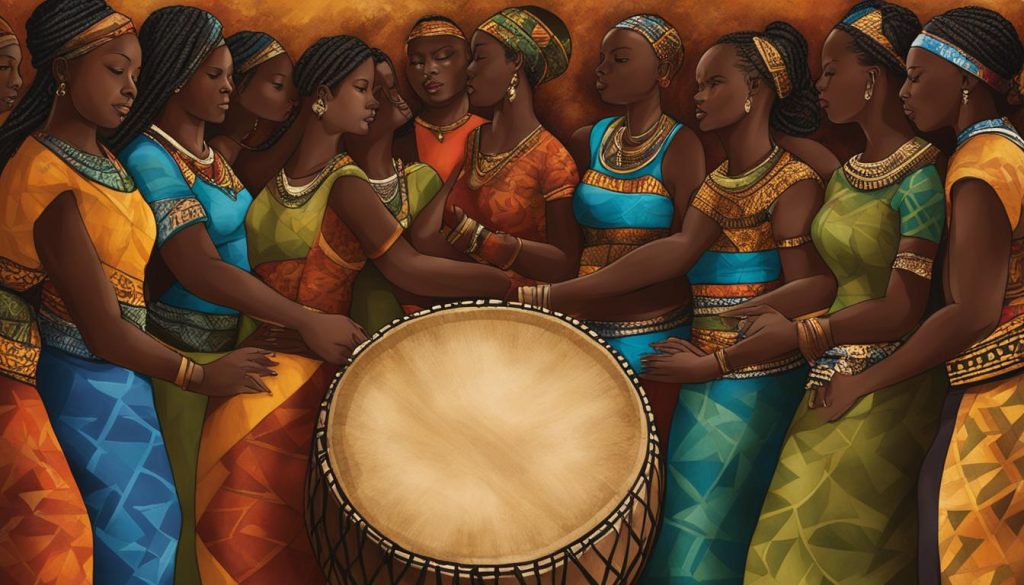The djembe drum, pronounced JEM-bay, is a versatile percussion instrument known for its wide range of pitches. But, when was the djembe drum invented?
It was invented in the 12th century by the Mandinke tribe in what is now Mali, West Africa.
The drum is carved from a single piece of tree trunk, typically using wood from Lenge trees, and features a unique goblet shape. The head of the drum is traditionally made from goat skin.

Content
Djembe Drum Invention
The design of the djembe drum is unique and contributes to its versatile sound. Carved and hollowed out of a single piece of tree trunk, the djembe features a large bowl-shaped chamber in the upper part and a narrow elongated lower section.
This design allows for resonance and projection of the sound, creating a powerful and dynamic instrument.
The head of the djembe drum is traditionally made from goat skin. This choice of material produces piercing high-pitched tones and slap sounds when struck.
The goat skin is carefully selected and treated to ensure optimum sound quality and durability.
When playing the djembe, three main sounds can be produced: bass, tone, and slap. These sounds are achieved by striking different areas of the drum’s skin with the hands.
The bass sound is created by hitting the center of the drum with an open hand, producing a deep and resonant tone.
The tone sound is achieved by striking the drum near the edge with the fingertips, resulting in a melodic and middle-pitched sound.
The slap sound is produced by hitting the drum near the edge with the palm and fingers, creating a sharp and percussive sound.
Proper tuning of the djembe drum is crucial for achieving good sound quality. The tension of the drumhead can be adjusted using a double-hoop system, allowing for fine-tuning of the pitch.
Skilled drummers can manipulate the tension to produce different tones and ensure that the drum is in harmony with other instruments.
The Cultural Significance of the Djembe Drum
The djembe drum holds immense cultural and ritualistic significance in the context of West African society. It has been an integral part of spiritual and cultural practices for generations, particularly in countries such as Mali, Guinea, Senegal, and others.
The drum’s historical and symbolic importance is deeply intertwined with storytelling, music, and dance.
In West African society, the djembe drum has traditionally been played by griots, respected court musicians who serve as oral historians and cultural custodians.
Griots use the djembe as a powerful tool for storytelling, employing rhythmic beats and melodies to convey important historical and cultural information to future generations.
The djembe drum is closely connected to singing and dancing, forming an essential part of traditional ceremonies, rituals, and celebrations.
It is often accompanied by specific songs and dance movements that hold deep symbolic meanings within the community.
Djembe drummers, also known as djembefola, play a pivotal role in preserving the traditions and music associated with the instrument.
They carry the responsibility of passing down their knowledge and skills to the next generation, ensuring the continuity of the cultural heritage embedded in the djembe drum.
The Role of Djembe Drummers
Djembe drummers play a crucial role within West African society, acting as cultural ambassadors and custodians of the instrument’s traditions.
They possess a profound understanding of the djembe’s rhythms, techniques, and cultural context, which enables them to inspire and entertain audiences.
Through their performances, djembe drummers evoke a sense of pride and unity, bridging generations and connecting individuals to their cultural roots.
The rhythm and energy of their drumming often elicit a strong emotional response, creating a shared experience that transcends linguistic and cultural barriers.
Furthermore, djembe drummers contribute to the preservation and evolution of the djembe’s rich musical heritage.
They explore new rhythms, experiment with different playing techniques, and collaborate with musicians from diverse backgrounds to ensure that the djembe remains relevant in a contemporary musical landscape.
Cultural Context of the Djembe
The djembe drum’s cultural significance extends beyond its role in music and dance. It serves as a symbol of community, communication, and collective identity within West African societies.
Through its rhythms and melodies, the djembe facilitates a sense of belonging and togetherness, fostering social harmony and cohesion.
In traditional West African communities, the djembe drum accompanies a variety of occasions, including weddings, funerals, and coming-of-age ceremonies.
Its presence signifies the importance of these events and reinforces the cultural values and beliefs associated with them.
Furthermore, the djembe drum serves as a means of communication among different communities and ethnic groups. Its distinct rhythms and patterns can convey specific messages, announce important news, or serve as a call to action.
In this way, the djembe drum becomes a powerful vessel for cultural expression and social interaction.
The Djembe Drum in West African Society:
| Aspect | Role |
|---|---|
| Spiritual and ritualistic practices | Integral part of ceremonies, rituals, and celebrations |
| Storytelling and cultural preservation | Used by griots to pass down historical and cultural information |
| Music and dance | Accompanies singing, dancing, and traditional performances |
| Community and unity | Serves as a symbol of collective identity and social cohesion |
| Communication | Conveys messages, news, and calls to action |

Djembe Invention and Evolution
The evolution of the djembe drum is a fascinating journey that spans centuries and is rooted in the rich cultural heritage of West Africa.
While the exact origins of the djembe are shrouded in mystery, historical accounts, and myths have shed light on its creation and its significance in the region.
According to oral traditions, the djembe drum is believed to have been invented by the Mandinka people around 1300 AD.
These skilled craftsmen carved the drum from a single piece of tree trunk, carefully shaping it into the iconic goblet shape that we know today. The drum’s unique design and construction made it ideal for producing a wide range of sounds and pitches.
One popular myth surrounding the creation of the djembe suggests that it evolved from large mortars used for pounding grain or millet.
Over time, the Mandinka people discovered the musical potential of these mortar-like objects and transformed them into powerful instruments of expression.
This myth not only demonstrates the ingenuity of the Mandinka people but also reinforces the deep cultural connection between the djembe and everyday life in West Africa.
The Role of Blacksmiths in Djembe Creation
Blacksmiths played a crucial role in the evolution of the djembe drum. It is believed that these skilled artisans were responsible for crafting the metal rings and tuning systems that allowed for precise tuning and adjustment of the drum’s goat skin head.
The blacksmiths’ expertise ensured that each djembe produced had exceptional sound quality and durability.
As the djembe drum gained popularity, it spread across West Africa, with different regions and tribes adopting their variations of the instrument.
These regional variations in design and playing techniques contributed to the diverse and vibrant world of djembe music.
The Djembe’s Global Recognition
In more recent history, the djembe gained global recognition through West African ballet companies and the release of African drumming albums.
In the 1950s and 1960s, the creation of ballets like Les Ballets Africains and Les Ballets Djoliba introduced the world to the dynamic rhythms and expressive movements associated with the djembe.
These performances showcased the cultural significance of the drum and its ability to captivate audiences with its powerful sound and energetic performances.
The release of African drumming albums in the 1980s and 1990s further popularized the djembe drum outside of West Africa. Musicians like Mamady Keïta and Famoudou Konaté showcased their virtuosity and shared the beauty of West African rhythms with the rest of the world.
Today, the djembe is celebrated for its ability to bridge cultural divides and create a sense of unity among musicians and audiences from diverse backgrounds.
| Year | Event |
|---|---|
| 1300 AD | Invention of the djembe drum by the Mandinka people. |
| 18th Century | Spread of the djembe across West Africa, with regional variations emerging. |
| 1950s-1960s | Global recognition through West African ballet companies. |
| 1980s-1990s | Release of African drumming albums, further popularizing the djembe. |
| Present | Celebration and continued use of the djembe drum in various music genres worldwide. |
Conclusion
The djembe drum boasts a rich and storied history that spans centuries. Invented by the Mandinke tribe in the 12th century, it has since become an integral part of West African culture, and its influence has resonated across the globe.
Its unique design and versatile sound have made it a beloved percussion instrument in various musical genres and communities.
With its deep cultural and ritualistic significance, the djembe is often at the heart of storytelling, singing, and dancing traditions.
Originally played by griots and esteemed court musicians, it has been passed down through generations, preserving important historical and cultural information.
The drum’s mesmerizing rhythms and melodies bring people together, creating a sense of community and unity.
Today, the djembe drum remains a cherished symbol of cultural heritage, known for its ability to transcend boundaries and connect individuals.
Whether played in traditional settings or introduced into contemporary music, the djembe’s enduring spirit carries a powerful message of unity, creativity, and celebration.
Its significance cannot be overstated, as it continues to inspire and captivate generations of music lovers worldwide.
